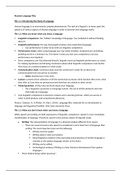Summary
Summary Language Files 12th edition
- Course
- Institution
- Book
Summary of Language Files (12th edition) ISBN: 9780814252703 (02) With this summary, I got a very good mark. This summary contains everything you need to finish the subject and also get a very good mark. Content: File 1.0-1.4 File 2.0-2.3 File 3.0-3.3 & 3.5 File 4.0-4.5 File 5.0-5.2, 5.4 and 5....
[Show more]




